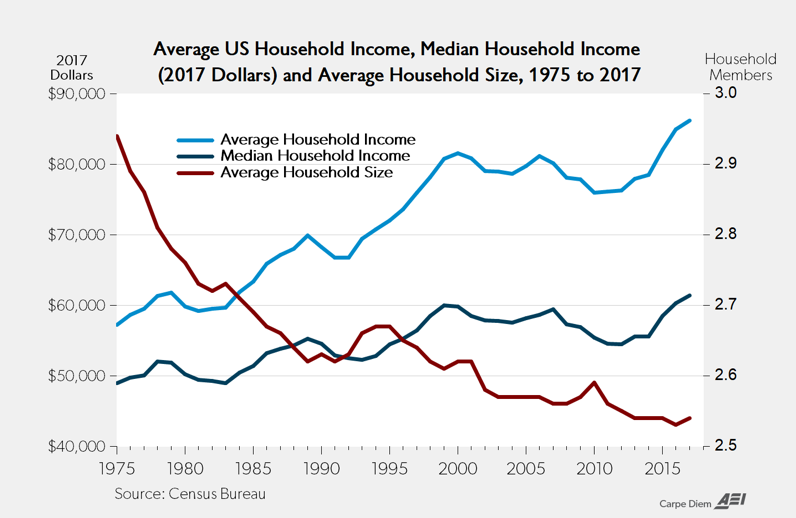
1.Median and Average Household Income, and Average Household Size. The chart above shows: a) average annual household income in 2017 dollars (dark blue line), b) median household income in 2017 dollars (light blue line), and c) average household size (brown line), all from 1975 to 2017.
Median household income last year of $61,372 was an increase of 1.8% from 2016 and brought median income for US households to the highest level ever, above the previous record level last year of $60,309. The income gain last year was the fifth consecutive annual increase in real median household income starting in 2013, following five consecutive declines from 2008 to 2012 due to the effects of the Great Recession. The last period of four consecutive gains in annual median household income was during the late 1990s at the end of the longest economic expansion in US history (120 months from March 1991 to March 2001). Although it doesn’t get as much attention as median income because it’s influenced by outliers on the high-end, average household income also increased to a new record level last year of $86,220, which was an increase of 1.5% from 2016 and the seventh consecutive annual increase starting in 2011.
Also notable is the fact that average size of US householdshas been falling steadily for the last 70 years (or more) and was 2.54 persons in 2017, up slightly from 2.53 persons in 2016, a record low. The 2.54 average members per household last year was down by 0.50 persons from the 2.94 average in 1975 and down by more than one full person since the 3.56 average persons per household in 1947 (not shown above).
Income adjusted for household size is calculated and presented below, but it should be obvious that a comparison of median household incomes over time is distorted because theaverage size of US households has been declining. It’s almost important to note that the typical US household in 2017 had an annual income of $12,464 more (in 2017 dollars) than the typical household in 1975 – that’s more than $1,000 in additional income every month for the typical household today compared to 42 years ago. And when you consider that the cost of most manufactured goods and many services including clothing, footwear, appliances, electronics, TVs, household furnishings, sporting goods, airline travel, telephone service, computers and automobiles have become cheaper and more affordable over time (relative to increases in overall consumer prices and incomes), along with the increased availability of services that are now almost free (GPS, music, cameras, Craigslist listings, Wikipedia information, Facebook, Twitter, blogs, etc.), that $12,000 annual increase in real household income since 1975 translates into a much higher standard of living for the average American today compared to a generation ago.
Via MJP